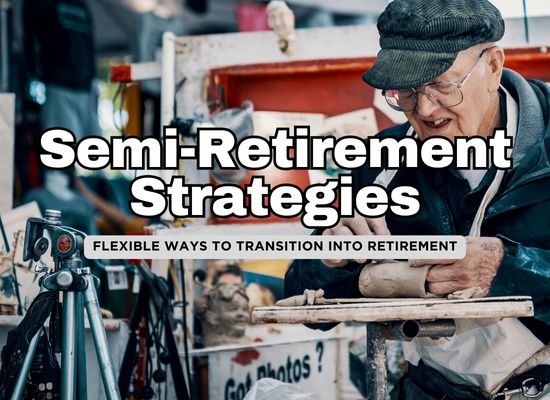Retirement is no longer an abrupt transition from full-time work to complete leisure. More professionals are choosing semi-retirement or phased retirement plans to maintain financial stability, stay mentally engaged, and enjoy a more flexible lifestyle. Instead of stepping away from work entirely, they reduce their hours, take on consulting roles, or turn hobbies into income streams. This approach allows for a smoother transition into retirement while still providing structure and purpose.
1️⃣ Flexible Work Schedules: Earning While Enjoying More Freedom ⏳
Many companies offer phased retirement programs that allow employees to gradually reduce their work hours over several years. This option provides continued income while allowing workers to adjust to having more free time.
- A senior accountant moves from full-time to three days a week, keeping their benefits while mentoring junior staff.
- A college professor transitions to part-time teaching, reducing workload while staying involved in academia.
- A project manager negotiates a four-day workweek before retiring completely, maintaining income while adjusting to more personal time.
Why it works:
- Provides a steady income stream while easing into retirement.
- Allows access to benefits like health insurance and 401(k) contributions for longer.
- Helps retirees stay mentally and socially engaged with their industry.
2️⃣ Consulting and Freelancing: Using Expertise on Your Terms 💼
Many professionals shift into consulting or freelance work, allowing them to stay active in their field while enjoying greater flexibility. This option lets retirees set their own hours, choose projects they’re passionate about, and continue earning without long-term commitments.
- A retired marketing executive consults with startups on branding and digital strategy.
- A former attorney takes on part-time legal advising for small businesses.
- An IT specialist provides cybersecurity audits as a freelancer, choosing only a few projects per month.
Why it works:
- Offers high earning potential with fewer working hours.
- Provides intellectual stimulation without the pressure of a full-time job.
- Keeps professional networks strong, which can lead to more opportunities.
3️⃣ Turning Hobbies Into Income: Profitable Passion Projects 🎨
Semi-retirement is the perfect time to monetize hobbies and interests. Whether it’s starting a small business, teaching a skill, or selling creative work, passion-driven income provides both fulfillment and financial security.
- A retired engineer opens an online shop selling handmade wooden furniture.
- A former journalist launches a podcast and earns through sponsorships.
- A fitness enthusiast becomes a part-time personal trainer, working with select clients.
Why it works:
- Allows retirees to work on their own terms and schedule.
- Generates supplemental income while doing something enjoyable.
- Keeps them mentally and physically active, reducing the risks of a sedentary retirement.
4️⃣ Passive Income Streams: Earning Without Full-Time Work 💰
Semi-retirement is an excellent time to build passive income sources that generate steady earnings with minimal daily effort. This strategy helps retirees supplement their savings while maintaining financial freedom.
- A former business owner invests in rental properties, collecting monthly income without day-to-day involvement.
- A retired financial analyst writes an investment guide and sells it as an e-book, generating royalties.
- A former musician licenses their old recordings, earning passive income from streaming services.
Why it works:
- Reduces reliance on retirement savings.
- Provides ongoing financial security without a full-time job.
- Allows retirees to focus on personal interests while earning.
5️⃣ Remote and Gig Work: Staying Flexible While Making Money 🌍
With more companies embracing remote work, semi-retirees can take advantage of flexible job opportunities without commuting or adhering to strict office hours. Gig work, such as online tutoring, virtual assistance, or contract-based writing, allows for even more control over schedules.
- A retired educator teaches English online for a few hours a week.
- A former executive picks up short-term business consulting gigs.
- A retired accountant offers bookkeeping services to small businesses remotely.
Why it works:
- Provides flexible income while allowing for travel or more leisure time.
- Keeps retirees mentally active and engaged.
- Offers opportunities to explore new career interests without full commitment.
6️⃣ Seasonal and Part-Time Jobs: Earning on Your Own Schedule 📅
Some retirees prefer hands-on work that keeps them engaged but without the pressure of long-term commitments. Seasonal and part-time roles provide extra income while allowing for extended breaks.
- A former retail manager works during the holiday season for extra earnings.
- A retired pilot picks up seasonal work as a tour guide at a national park.
- A former chef helps a local restaurant during peak dining months.
Why it works:
- Offers structure without a full-time schedule.
- Provides social interaction and a sense of purpose.
- Allows retirees to work only when they want or need extra income.
7️⃣ Bridge Employment: A Smooth Transition to Full Retirement 🌉
Bridge employment refers to taking a lower-stress or different job before fully retiring. This can be within the same company, in a different industry, or even in a new role that aligns with personal interests.
- A corporate executive moves into an advisory role within their company, working reduced hours.
- A former police officer transitions into campus security for a local university.
- A marketing director takes a part-time role mentoring startups at a business incubator.
Why it works:
- Provides financial stability during the transition.
- Allows retirees to shift into a new career path at a slower pace.
- Keeps them engaged without the demands of a full-time job.
8️⃣ Teaching and Coaching: Sharing Knowledge While Earning 📚
Many semi-retirees turn to teaching, coaching, or mentoring as a way to stay active while sharing their expertise. This can be done through formal educational institutions, private coaching, or online platforms.
- A retired engineer teaches technical skills at a community college.
- A former athlete offers private coaching sessions for young players.
- A seasoned executive mentors up-and-coming entrepreneurs through a consulting firm.
Why it works:
- Keeps retirees mentally stimulated and socially engaged.
- Offers flexible schedules and remote options.
- Provides a way to give back while still earning income.
9️⃣ Volunteering with Stipends: Giving Back with Financial Perks ❤️
Many organizations offer stipends or small financial incentives for volunteers, making it possible to contribute to meaningful causes while receiving a modest income.
- A retired nurse volunteers at a medical outreach program with a travel stipend.
- A former corporate leader joins a nonprofit board with an annual honorarium.
- A retired teacher tutors underserved students through a foundation that covers expenses.
Why it works:
- Provides a sense of purpose and contribution.
- Helps retirees stay engaged with their communities.
- Offers financial support for travel, meals, or living expenses.
🔟 Investing in Retirement Business Ventures: Building Something New 🚀
Some semi-retirees take the opportunity to launch a small business, either as a solo project or with family members. These ventures can be passion-driven or focused on long-term financial sustainability.
- A retired chef opens a small catering business, working on select events.
- A former IT professional starts a cybersecurity consulting firm from home.
- A couple opens a bed-and-breakfast, blending work with lifestyle.
Why it works:
- Creates financial independence and passive income potential.
- Allows retirees to work on their own terms.
- Provides an exciting new challenge in retirement.
Semi-retirement and phased retirement plans are transforming the way people approach the later stages of their careers. Rather than stopping work entirely, many retirees are choosing to gradually scale back, explore new opportunities, and maintain financial stability while enjoying greater freedom.
Whether through part-time work, consulting, teaching, or even starting a small business, the modern approach to retirement is more flexible, personalized, and fulfilling than ever before. Those who embrace these strategies can extend their financial security, stay mentally engaged, and enjoy a balanced transition into full retirement.



